Solar Cells and Quantum Dots: Semiconductor Energy Transfer Report
VerifiedAdded on 2022/10/04
|24
|7144
|382
Report
AI Summary
This report provides a comprehensive overview of solar cells and quantum dots, delving into the principles of energy transfer in semiconductors and the broader context of solar energy. It discusses various types of solar cells, including photovoltaic and PEC cells, along with their efficiencies, and explores the concept of quantum dot solar cells, focusing on core-shell quantum dots and quantum confinement. The report also touches upon self-assembled photonic structures, photonic crystals, and photoelectrochemistry at quantum dot-sensitized films. Overall, the report aims to provide a clear understanding of solar energy conversion technologies, emphasizing the role of quantum dots in enhancing efficiency and exploring various related concepts. This report is contributed by a student to be published on the website Desklib. Desklib is a platform which provides all the necessary AI based study tools for students.

Running head: SOLAR CELLS AND QUANTUM DOTS
Solar Cells and Quantum Dots
Name of the Student
Name of the University
Author Note
Solar Cells and Quantum Dots
Name of the Student
Name of the University
Author Note
Paraphrase This Document
Need a fresh take? Get an instant paraphrase of this document with our AI Paraphraser
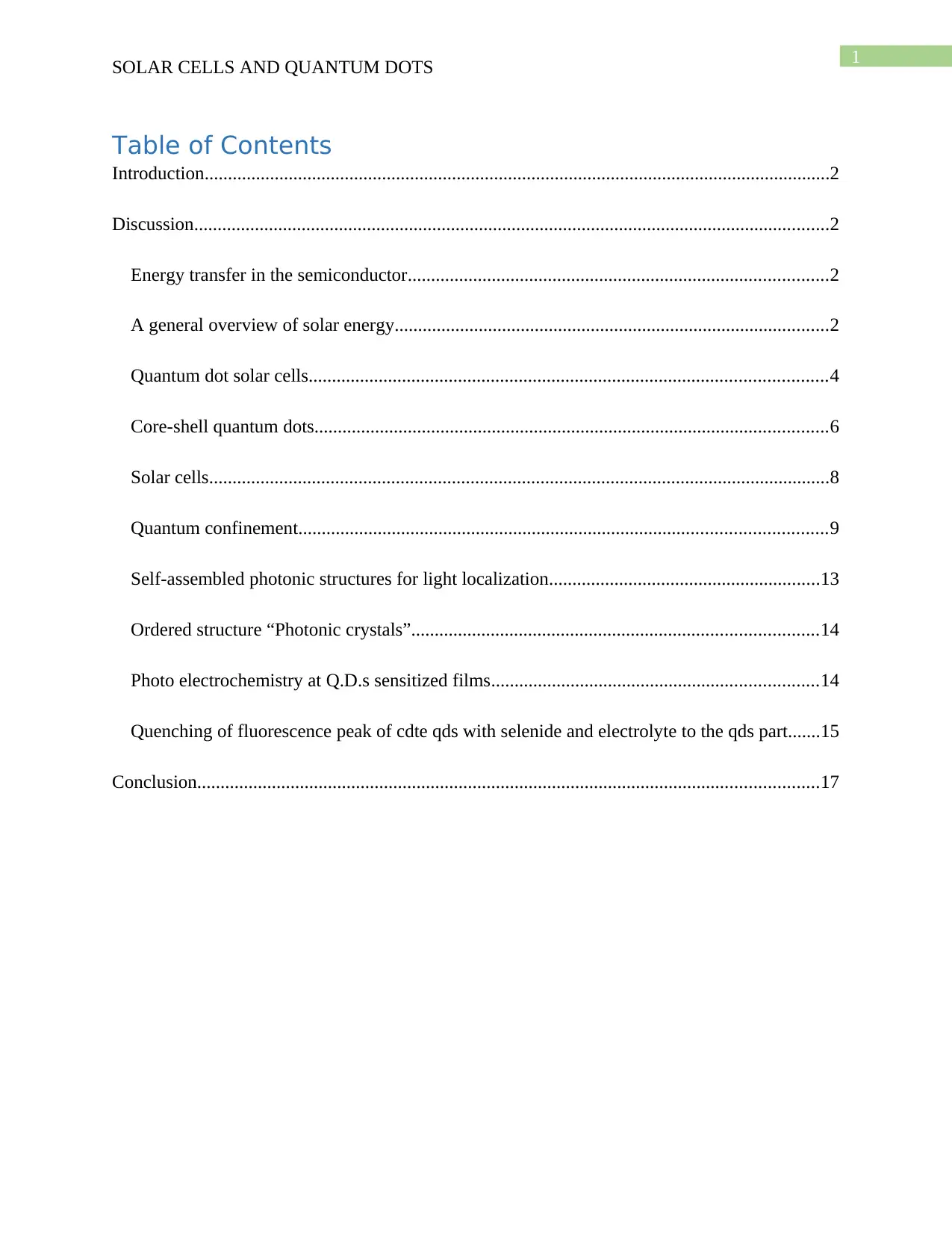
1
SOLAR CELLS AND QUANTUM DOTS
Table of Contents
Introduction......................................................................................................................................2
Discussion........................................................................................................................................2
Energy transfer in the semiconductor..........................................................................................2
A general overview of solar energy.............................................................................................2
Quantum dot solar cells...............................................................................................................4
Core-shell quantum dots..............................................................................................................6
Solar cells.....................................................................................................................................8
Quantum confinement.................................................................................................................9
Self-assembled photonic structures for light localization..........................................................13
Ordered structure “Photonic crystals”.......................................................................................14
Photo electrochemistry at Q.D.s sensitized films......................................................................14
Quenching of fluorescence peak of cdte qds with selenide and electrolyte to the qds part.......15
Conclusion.....................................................................................................................................17
SOLAR CELLS AND QUANTUM DOTS
Table of Contents
Introduction......................................................................................................................................2
Discussion........................................................................................................................................2
Energy transfer in the semiconductor..........................................................................................2
A general overview of solar energy.............................................................................................2
Quantum dot solar cells...............................................................................................................4
Core-shell quantum dots..............................................................................................................6
Solar cells.....................................................................................................................................8
Quantum confinement.................................................................................................................9
Self-assembled photonic structures for light localization..........................................................13
Ordered structure “Photonic crystals”.......................................................................................14
Photo electrochemistry at Q.D.s sensitized films......................................................................14
Quenching of fluorescence peak of cdte qds with selenide and electrolyte to the qds part.......15
Conclusion.....................................................................................................................................17
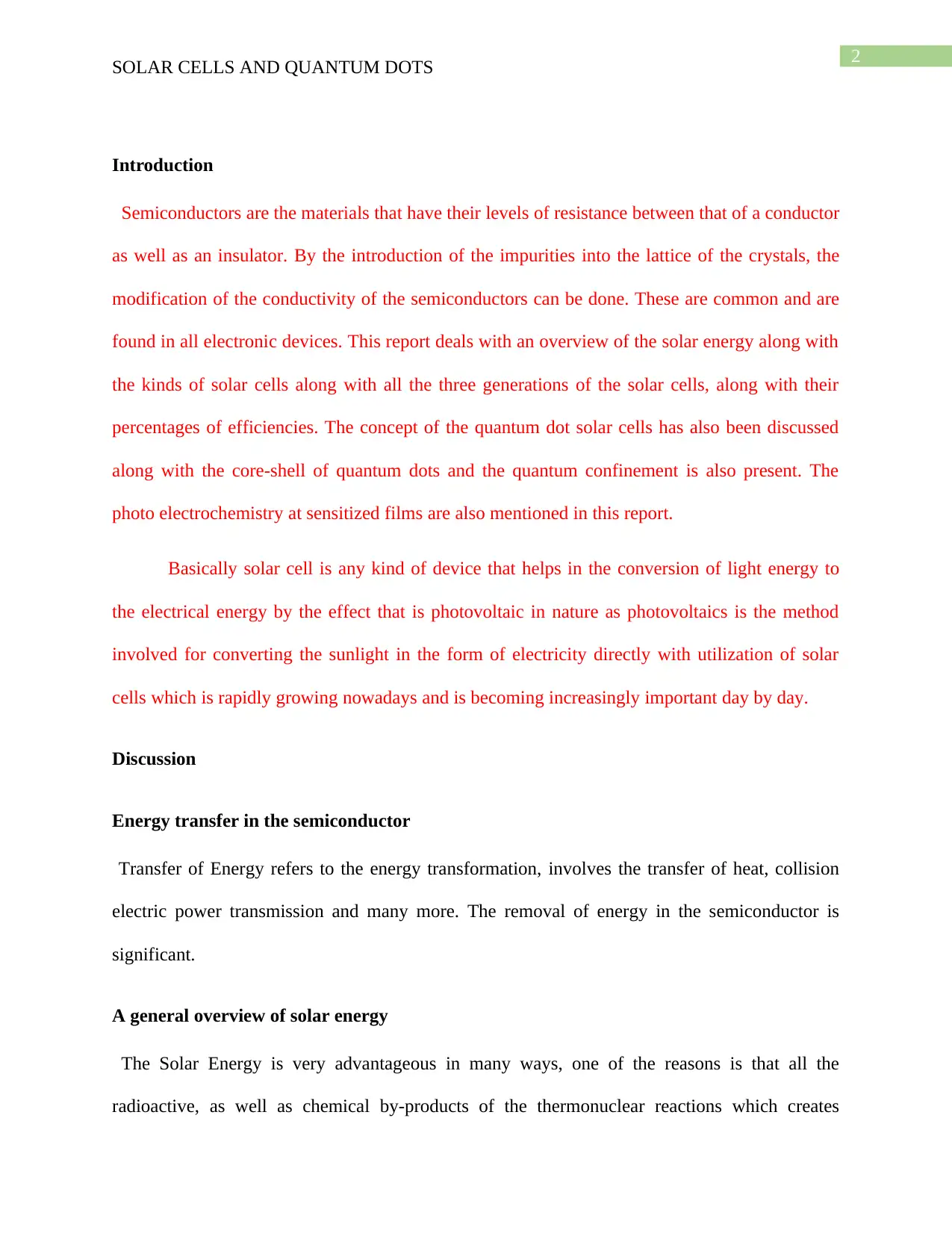
2
SOLAR CELLS AND QUANTUM DOTS
Introduction
Semiconductors are the materials that have their levels of resistance between that of a conductor
as well as an insulator. By the introduction of the impurities into the lattice of the crystals, the
modification of the conductivity of the semiconductors can be done. These are common and are
found in all electronic devices. This report deals with an overview of the solar energy along with
the kinds of solar cells along with all the three generations of the solar cells, along with their
percentages of efficiencies. The concept of the quantum dot solar cells has also been discussed
along with the core-shell of quantum dots and the quantum confinement is also present. The
photo electrochemistry at sensitized films are also mentioned in this report.
Basically solar cell is any kind of device that helps in the conversion of light energy to
the electrical energy by the effect that is photovoltaic in nature as photovoltaics is the method
involved for converting the sunlight in the form of electricity directly with utilization of solar
cells which is rapidly growing nowadays and is becoming increasingly important day by day.
Discussion
Energy transfer in the semiconductor
Transfer of Energy refers to the energy transformation, involves the transfer of heat, collision
electric power transmission and many more. The removal of energy in the semiconductor is
significant.
A general overview of solar energy
The Solar Energy is very advantageous in many ways, one of the reasons is that all the
radioactive, as well as chemical by-products of the thermonuclear reactions which creates
SOLAR CELLS AND QUANTUM DOTS
Introduction
Semiconductors are the materials that have their levels of resistance between that of a conductor
as well as an insulator. By the introduction of the impurities into the lattice of the crystals, the
modification of the conductivity of the semiconductors can be done. These are common and are
found in all electronic devices. This report deals with an overview of the solar energy along with
the kinds of solar cells along with all the three generations of the solar cells, along with their
percentages of efficiencies. The concept of the quantum dot solar cells has also been discussed
along with the core-shell of quantum dots and the quantum confinement is also present. The
photo electrochemistry at sensitized films are also mentioned in this report.
Basically solar cell is any kind of device that helps in the conversion of light energy to
the electrical energy by the effect that is photovoltaic in nature as photovoltaics is the method
involved for converting the sunlight in the form of electricity directly with utilization of solar
cells which is rapidly growing nowadays and is becoming increasingly important day by day.
Discussion
Energy transfer in the semiconductor
Transfer of Energy refers to the energy transformation, involves the transfer of heat, collision
electric power transmission and many more. The removal of energy in the semiconductor is
significant.
A general overview of solar energy
The Solar Energy is very advantageous in many ways, one of the reasons is that all the
radioactive, as well as chemical by-products of the thermonuclear reactions which creates
⊘ This is a preview!⊘
Do you want full access?
Subscribe today to unlock all pages.

Trusted by 1+ million students worldwide
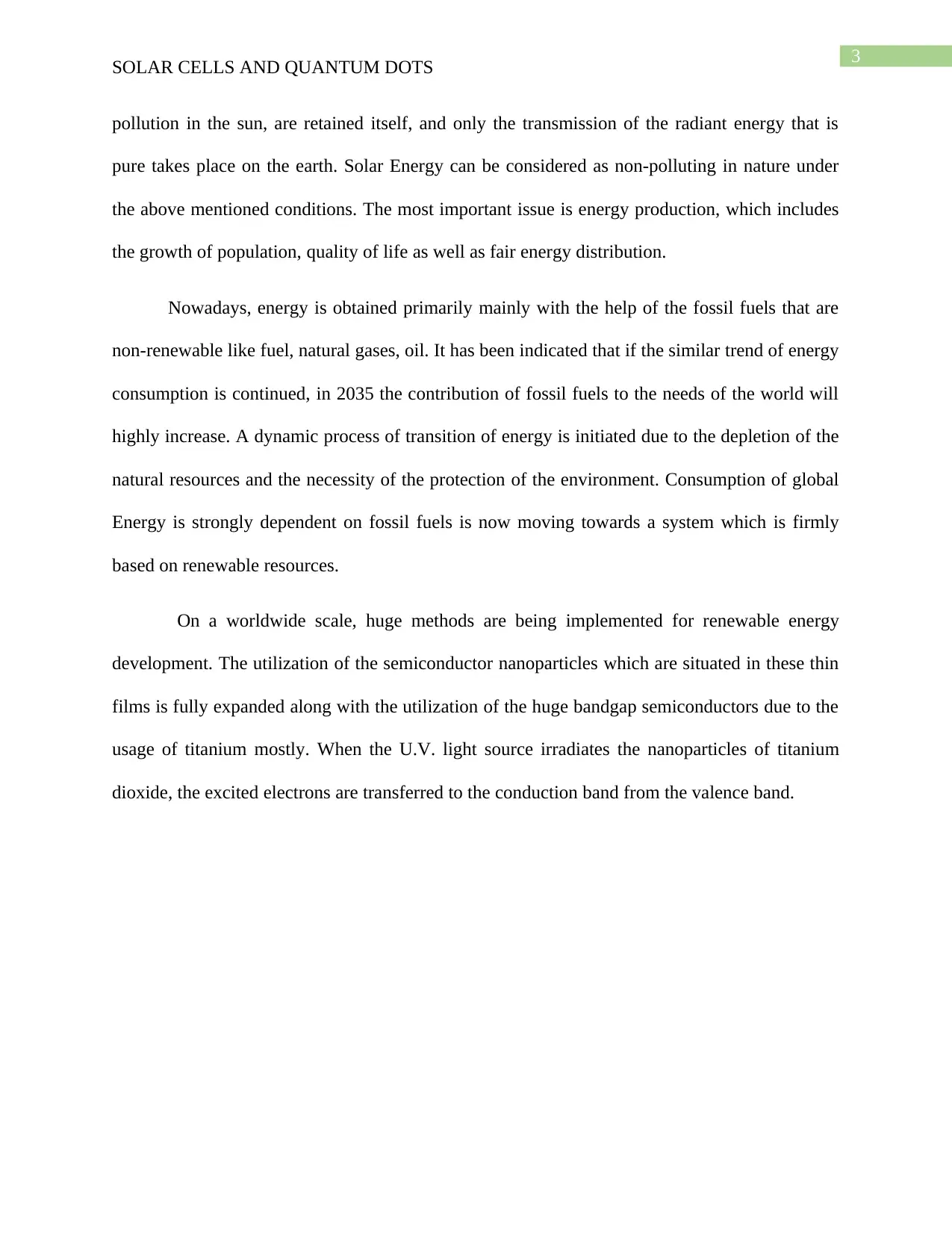
3
SOLAR CELLS AND QUANTUM DOTS
pollution in the sun, are retained itself, and only the transmission of the radiant energy that is
pure takes place on the earth. Solar Energy can be considered as non-polluting in nature under
the above mentioned conditions. The most important issue is energy production, which includes
the growth of population, quality of life as well as fair energy distribution.
Nowadays, energy is obtained primarily mainly with the help of the fossil fuels that are
non-renewable like fuel, natural gases, oil. It has been indicated that if the similar trend of energy
consumption is continued, in 2035 the contribution of fossil fuels to the needs of the world will
highly increase. A dynamic process of transition of energy is initiated due to the depletion of the
natural resources and the necessity of the protection of the environment. Consumption of global
Energy is strongly dependent on fossil fuels is now moving towards a system which is firmly
based on renewable resources.
On a worldwide scale, huge methods are being implemented for renewable energy
development. The utilization of the semiconductor nanoparticles which are situated in these thin
films is fully expanded along with the utilization of the huge bandgap semiconductors due to the
usage of titanium mostly. When the U.V. light source irradiates the nanoparticles of titanium
dioxide, the excited electrons are transferred to the conduction band from the valence band.
SOLAR CELLS AND QUANTUM DOTS
pollution in the sun, are retained itself, and only the transmission of the radiant energy that is
pure takes place on the earth. Solar Energy can be considered as non-polluting in nature under
the above mentioned conditions. The most important issue is energy production, which includes
the growth of population, quality of life as well as fair energy distribution.
Nowadays, energy is obtained primarily mainly with the help of the fossil fuels that are
non-renewable like fuel, natural gases, oil. It has been indicated that if the similar trend of energy
consumption is continued, in 2035 the contribution of fossil fuels to the needs of the world will
highly increase. A dynamic process of transition of energy is initiated due to the depletion of the
natural resources and the necessity of the protection of the environment. Consumption of global
Energy is strongly dependent on fossil fuels is now moving towards a system which is firmly
based on renewable resources.
On a worldwide scale, huge methods are being implemented for renewable energy
development. The utilization of the semiconductor nanoparticles which are situated in these thin
films is fully expanded along with the utilization of the huge bandgap semiconductors due to the
usage of titanium mostly. When the U.V. light source irradiates the nanoparticles of titanium
dioxide, the excited electrons are transferred to the conduction band from the valence band.
Paraphrase This Document
Need a fresh take? Get an instant paraphrase of this document with our AI Paraphraser
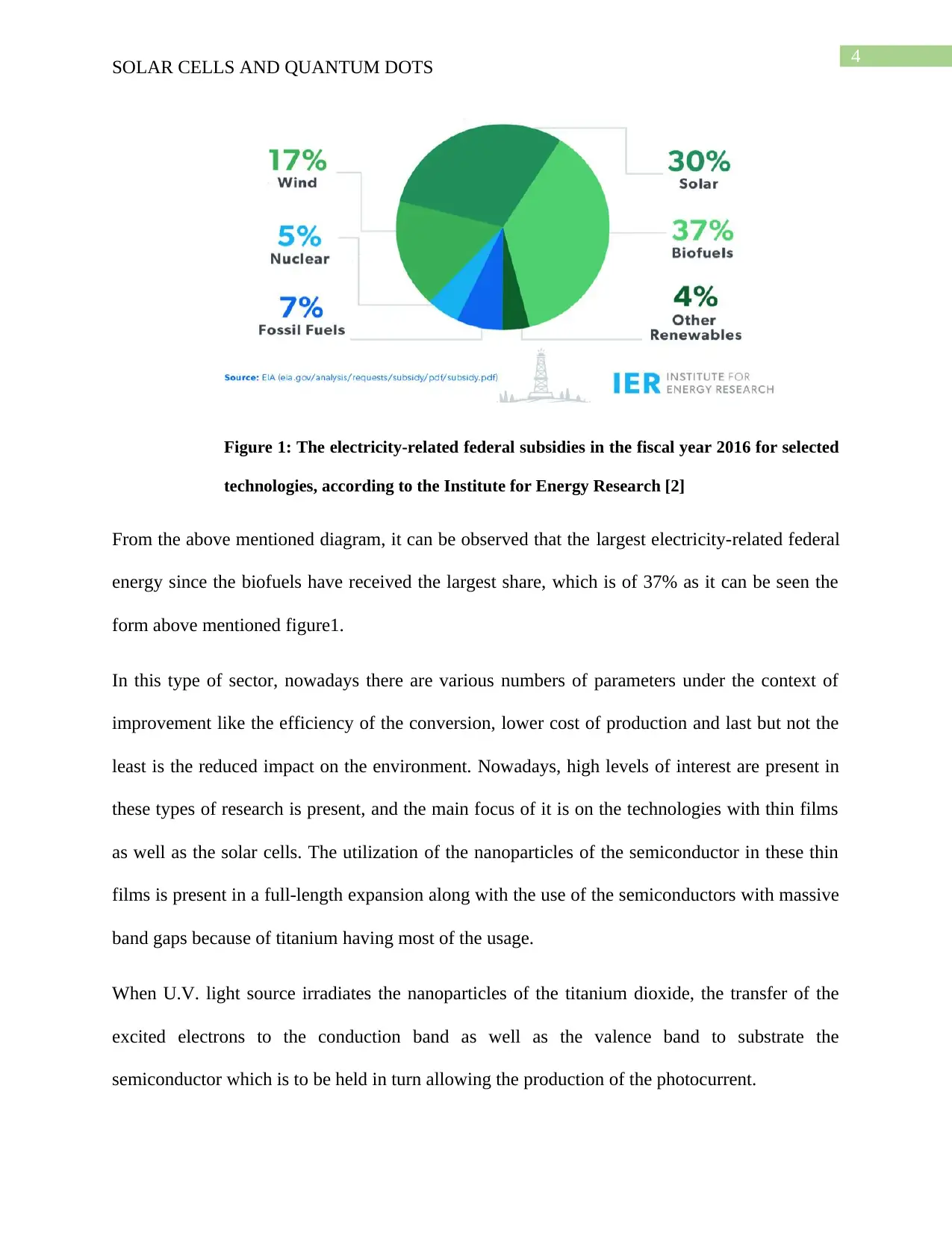
4
SOLAR CELLS AND QUANTUM DOTS
Figure 1: The electricity-related federal subsidies in the fiscal year 2016 for selected
technologies, according to the Institute for Energy Research [2]
From the above mentioned diagram, it can be observed that the largest electricity-related federal
energy since the biofuels have received the largest share, which is of 37% as it can be seen the
form above mentioned figure1.
In this type of sector, nowadays there are various numbers of parameters under the context of
improvement like the efficiency of the conversion, lower cost of production and last but not the
least is the reduced impact on the environment. Nowadays, high levels of interest are present in
these types of research is present, and the main focus of it is on the technologies with thin films
as well as the solar cells. The utilization of the nanoparticles of the semiconductor in these thin
films is present in a full-length expansion along with the use of the semiconductors with massive
band gaps because of titanium having most of the usage.
When U.V. light source irradiates the nanoparticles of the titanium dioxide, the transfer of the
excited electrons to the conduction band as well as the valence band to substrate the
semiconductor which is to be held in turn allowing the production of the photocurrent.
SOLAR CELLS AND QUANTUM DOTS
Figure 1: The electricity-related federal subsidies in the fiscal year 2016 for selected
technologies, according to the Institute for Energy Research [2]
From the above mentioned diagram, it can be observed that the largest electricity-related federal
energy since the biofuels have received the largest share, which is of 37% as it can be seen the
form above mentioned figure1.
In this type of sector, nowadays there are various numbers of parameters under the context of
improvement like the efficiency of the conversion, lower cost of production and last but not the
least is the reduced impact on the environment. Nowadays, high levels of interest are present in
these types of research is present, and the main focus of it is on the technologies with thin films
as well as the solar cells. The utilization of the nanoparticles of the semiconductor in these thin
films is present in a full-length expansion along with the use of the semiconductors with massive
band gaps because of titanium having most of the usage.
When U.V. light source irradiates the nanoparticles of the titanium dioxide, the transfer of the
excited electrons to the conduction band as well as the valence band to substrate the
semiconductor which is to be held in turn allowing the production of the photocurrent.
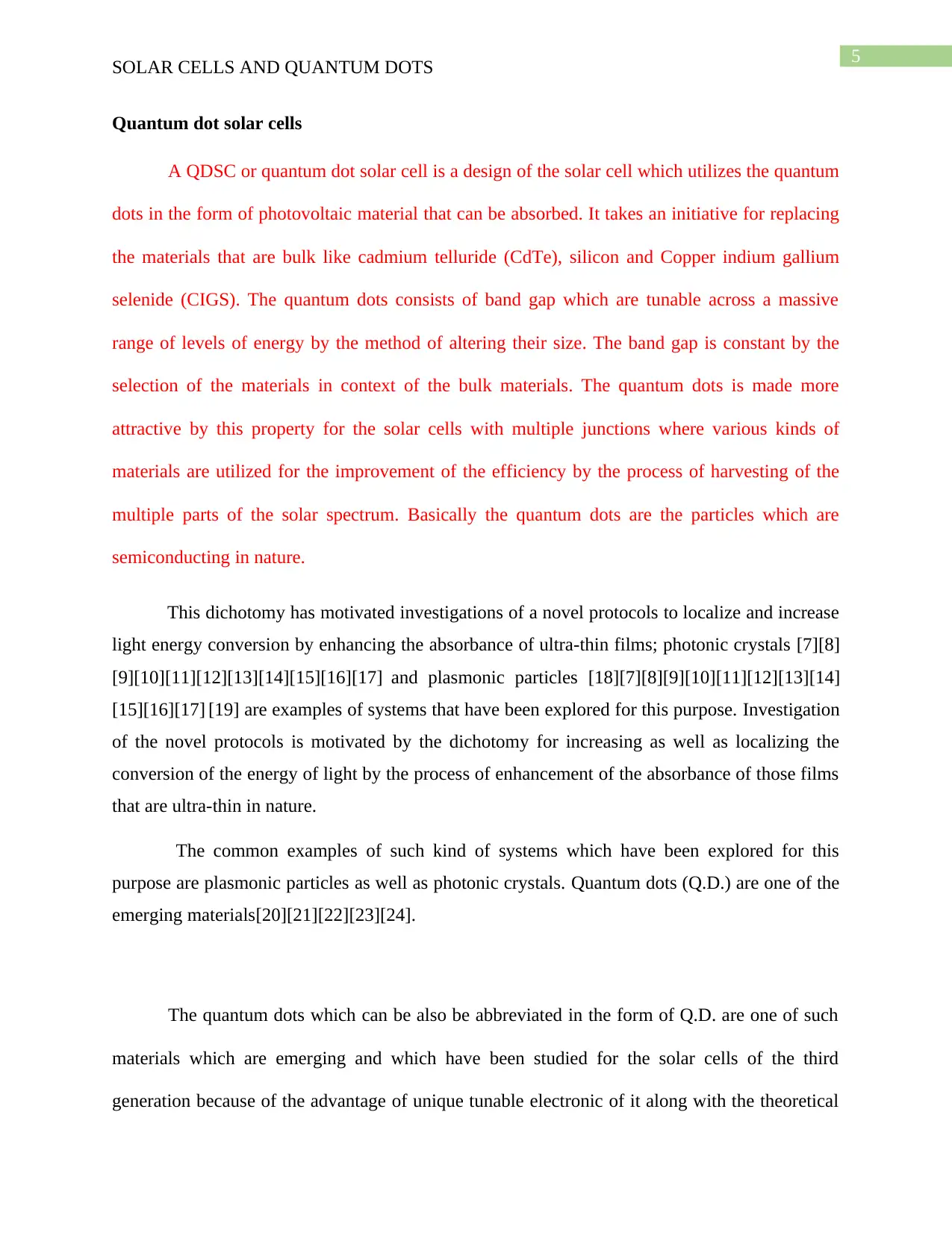
5
SOLAR CELLS AND QUANTUM DOTS
Quantum dot solar cells
A QDSC or quantum dot solar cell is a design of the solar cell which utilizes the quantum
dots in the form of photovoltaic material that can be absorbed. It takes an initiative for replacing
the materials that are bulk like cadmium telluride (CdTe), silicon and Copper indium gallium
selenide (CIGS). The quantum dots consists of band gap which are tunable across a massive
range of levels of energy by the method of altering their size. The band gap is constant by the
selection of the materials in context of the bulk materials. The quantum dots is made more
attractive by this property for the solar cells with multiple junctions where various kinds of
materials are utilized for the improvement of the efficiency by the process of harvesting of the
multiple parts of the solar spectrum. Basically the quantum dots are the particles which are
semiconducting in nature.
This dichotomy has motivated investigations of a novel protocols to localize and increase
light energy conversion by enhancing the absorbance of ultra-thin films; photonic crystals [7][8]
[9][10][11][12][13][14][15][16][17] and plasmonic particles [18][7][8][9][10][11][12][13][14]
[15][16][17] [19] are examples of systems that have been explored for this purpose. Investigation
of the novel protocols is motivated by the dichotomy for increasing as well as localizing the
conversion of the energy of light by the process of enhancement of the absorbance of those films
that are ultra-thin in nature.
The common examples of such kind of systems which have been explored for this
purpose are plasmonic particles as well as photonic crystals. Quantum dots (Q.D.) are one of the
emerging materials[20][21][22][23][24].
The quantum dots which can be also be abbreviated in the form of Q.D. are one of such
materials which are emerging and which have been studied for the solar cells of the third
generation because of the advantage of unique tunable electronic of it along with the theoretical
SOLAR CELLS AND QUANTUM DOTS
Quantum dot solar cells
A QDSC or quantum dot solar cell is a design of the solar cell which utilizes the quantum
dots in the form of photovoltaic material that can be absorbed. It takes an initiative for replacing
the materials that are bulk like cadmium telluride (CdTe), silicon and Copper indium gallium
selenide (CIGS). The quantum dots consists of band gap which are tunable across a massive
range of levels of energy by the method of altering their size. The band gap is constant by the
selection of the materials in context of the bulk materials. The quantum dots is made more
attractive by this property for the solar cells with multiple junctions where various kinds of
materials are utilized for the improvement of the efficiency by the process of harvesting of the
multiple parts of the solar spectrum. Basically the quantum dots are the particles which are
semiconducting in nature.
This dichotomy has motivated investigations of a novel protocols to localize and increase
light energy conversion by enhancing the absorbance of ultra-thin films; photonic crystals [7][8]
[9][10][11][12][13][14][15][16][17] and plasmonic particles [18][7][8][9][10][11][12][13][14]
[15][16][17] [19] are examples of systems that have been explored for this purpose. Investigation
of the novel protocols is motivated by the dichotomy for increasing as well as localizing the
conversion of the energy of light by the process of enhancement of the absorbance of those films
that are ultra-thin in nature.
The common examples of such kind of systems which have been explored for this
purpose are plasmonic particles as well as photonic crystals. Quantum dots (Q.D.) are one of the
emerging materials[20][21][22][23][24].
The quantum dots which can be also be abbreviated in the form of Q.D. are one of such
materials which are emerging and which have been studied for the solar cells of the third
generation because of the advantage of unique tunable electronic of it along with the theoretical
⊘ This is a preview!⊘
Do you want full access?
Subscribe today to unlock all pages.

Trusted by 1+ million students worldwide
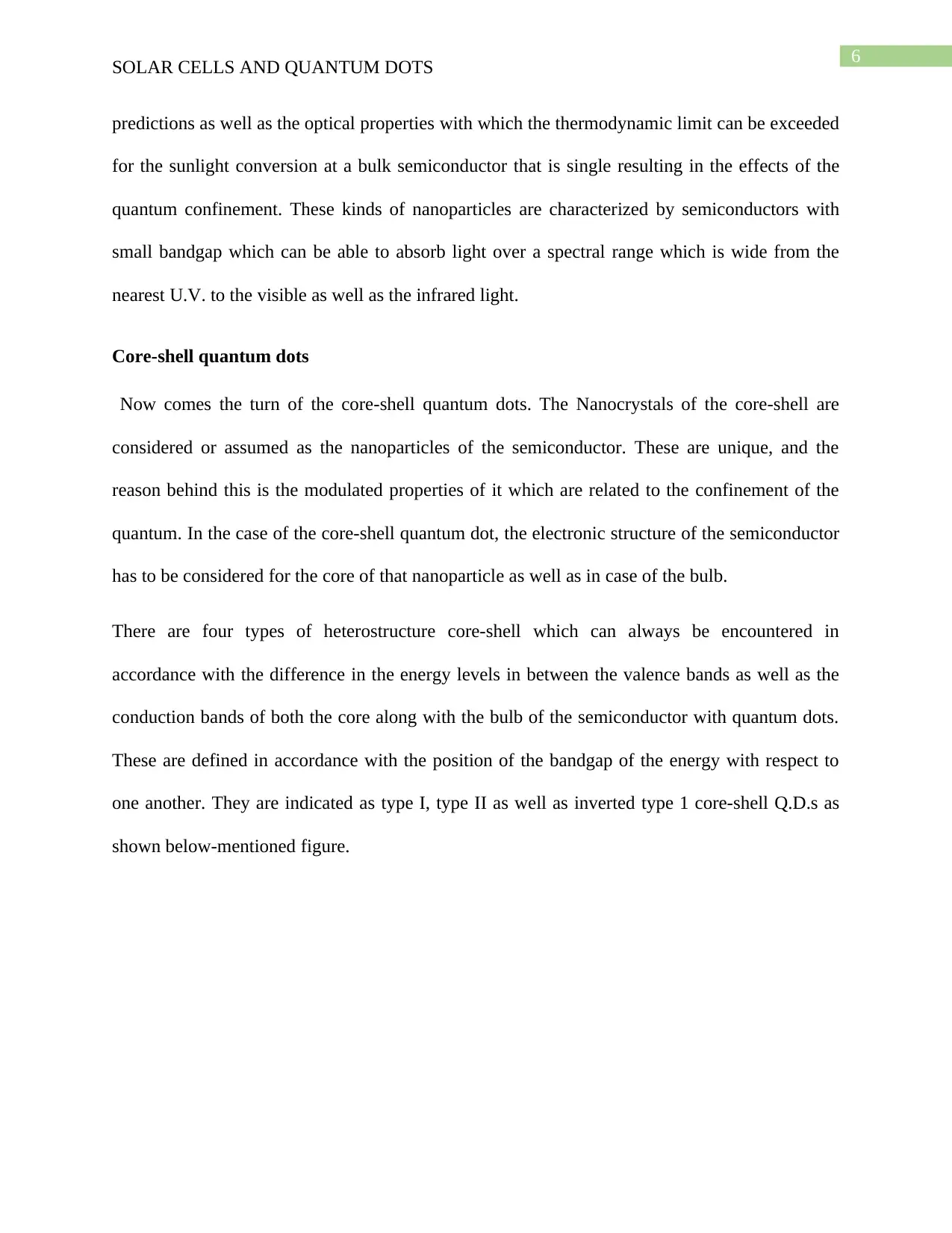
6
SOLAR CELLS AND QUANTUM DOTS
predictions as well as the optical properties with which the thermodynamic limit can be exceeded
for the sunlight conversion at a bulk semiconductor that is single resulting in the effects of the
quantum confinement. These kinds of nanoparticles are characterized by semiconductors with
small bandgap which can be able to absorb light over a spectral range which is wide from the
nearest U.V. to the visible as well as the infrared light.
Core-shell quantum dots
Now comes the turn of the core-shell quantum dots. The Nanocrystals of the core-shell are
considered or assumed as the nanoparticles of the semiconductor. These are unique, and the
reason behind this is the modulated properties of it which are related to the confinement of the
quantum. In the case of the core-shell quantum dot, the electronic structure of the semiconductor
has to be considered for the core of that nanoparticle as well as in case of the bulb.
There are four types of heterostructure core-shell which can always be encountered in
accordance with the difference in the energy levels in between the valence bands as well as the
conduction bands of both the core along with the bulb of the semiconductor with quantum dots.
These are defined in accordance with the position of the bandgap of the energy with respect to
one another. They are indicated as type I, type II as well as inverted type 1 core-shell Q.D.s as
shown below-mentioned figure.
SOLAR CELLS AND QUANTUM DOTS
predictions as well as the optical properties with which the thermodynamic limit can be exceeded
for the sunlight conversion at a bulk semiconductor that is single resulting in the effects of the
quantum confinement. These kinds of nanoparticles are characterized by semiconductors with
small bandgap which can be able to absorb light over a spectral range which is wide from the
nearest U.V. to the visible as well as the infrared light.
Core-shell quantum dots
Now comes the turn of the core-shell quantum dots. The Nanocrystals of the core-shell are
considered or assumed as the nanoparticles of the semiconductor. These are unique, and the
reason behind this is the modulated properties of it which are related to the confinement of the
quantum. In the case of the core-shell quantum dot, the electronic structure of the semiconductor
has to be considered for the core of that nanoparticle as well as in case of the bulb.
There are four types of heterostructure core-shell which can always be encountered in
accordance with the difference in the energy levels in between the valence bands as well as the
conduction bands of both the core along with the bulb of the semiconductor with quantum dots.
These are defined in accordance with the position of the bandgap of the energy with respect to
one another. They are indicated as type I, type II as well as inverted type 1 core-shell Q.D.s as
shown below-mentioned figure.
Paraphrase This Document
Need a fresh take? Get an instant paraphrase of this document with our AI Paraphraser
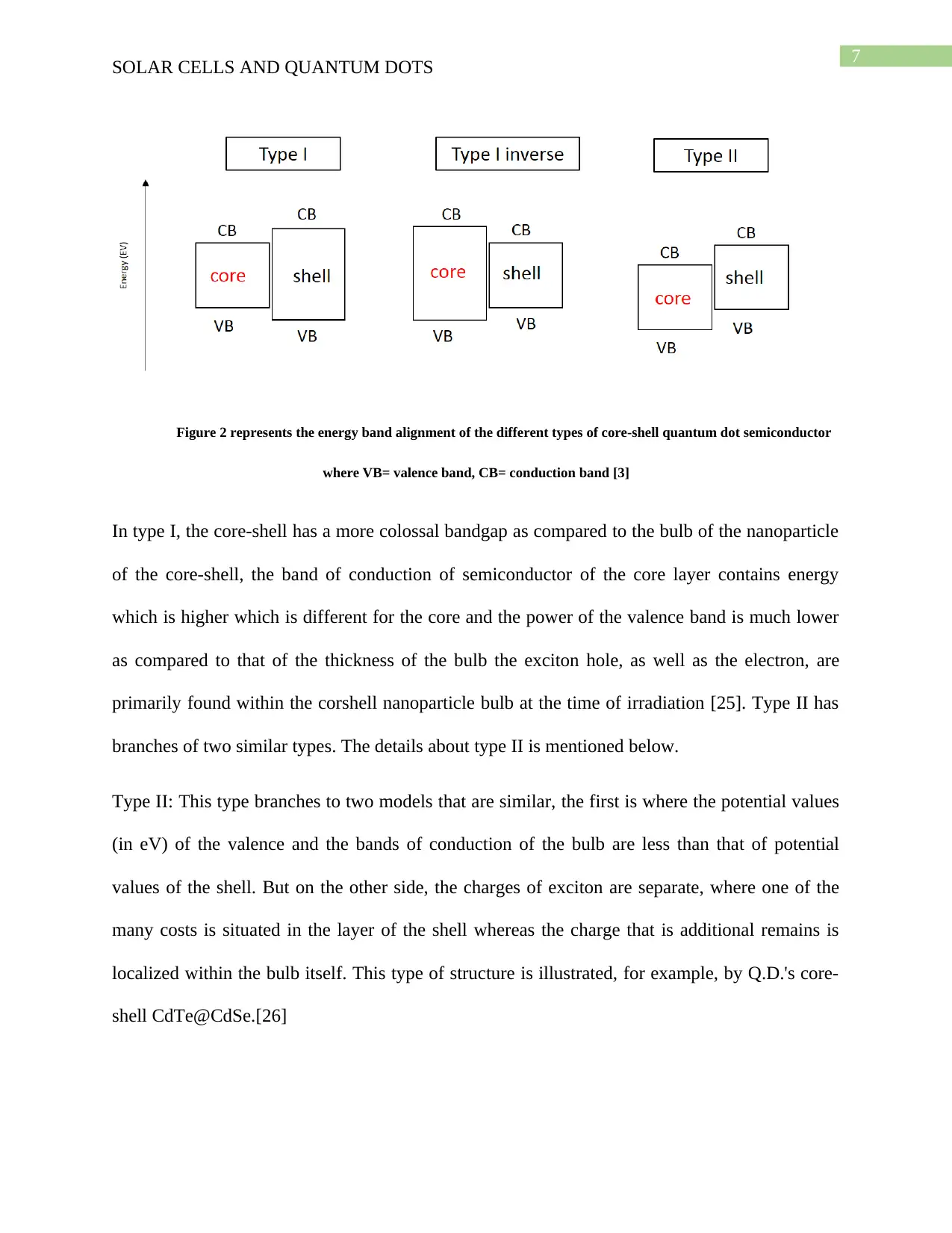
7
SOLAR CELLS AND QUANTUM DOTS
Figure 2 represents the energy band alignment of the different types of core-shell quantum dot semiconductor
where VB= valence band, CB= conduction band [3]
In type I, the core-shell has a more colossal bandgap as compared to the bulb of the nanoparticle
of the core-shell, the band of conduction of semiconductor of the core layer contains energy
which is higher which is different for the core and the power of the valence band is much lower
as compared to that of the thickness of the bulb the exciton hole, as well as the electron, are
primarily found within the corshell nanoparticle bulb at the time of irradiation [25]. Type II has
branches of two similar types. The details about type II is mentioned below.
Type II: This type branches to two models that are similar, the first is where the potential values
(in eV) of the valence and the bands of conduction of the bulb are less than that of potential
values of the shell. But on the other side, the charges of exciton are separate, where one of the
many costs is situated in the layer of the shell whereas the charge that is additional remains is
localized within the bulb itself. This type of structure is illustrated, for example, by Q.D.'s core-
shell CdTe@CdSe.[26]
SOLAR CELLS AND QUANTUM DOTS
Figure 2 represents the energy band alignment of the different types of core-shell quantum dot semiconductor
where VB= valence band, CB= conduction band [3]
In type I, the core-shell has a more colossal bandgap as compared to the bulb of the nanoparticle
of the core-shell, the band of conduction of semiconductor of the core layer contains energy
which is higher which is different for the core and the power of the valence band is much lower
as compared to that of the thickness of the bulb the exciton hole, as well as the electron, are
primarily found within the corshell nanoparticle bulb at the time of irradiation [25]. Type II has
branches of two similar types. The details about type II is mentioned below.
Type II: This type branches to two models that are similar, the first is where the potential values
(in eV) of the valence and the bands of conduction of the bulb are less than that of potential
values of the shell. But on the other side, the charges of exciton are separate, where one of the
many costs is situated in the layer of the shell whereas the charge that is additional remains is
localized within the bulb itself. This type of structure is illustrated, for example, by Q.D.'s core-
shell CdTe@CdSe.[26]
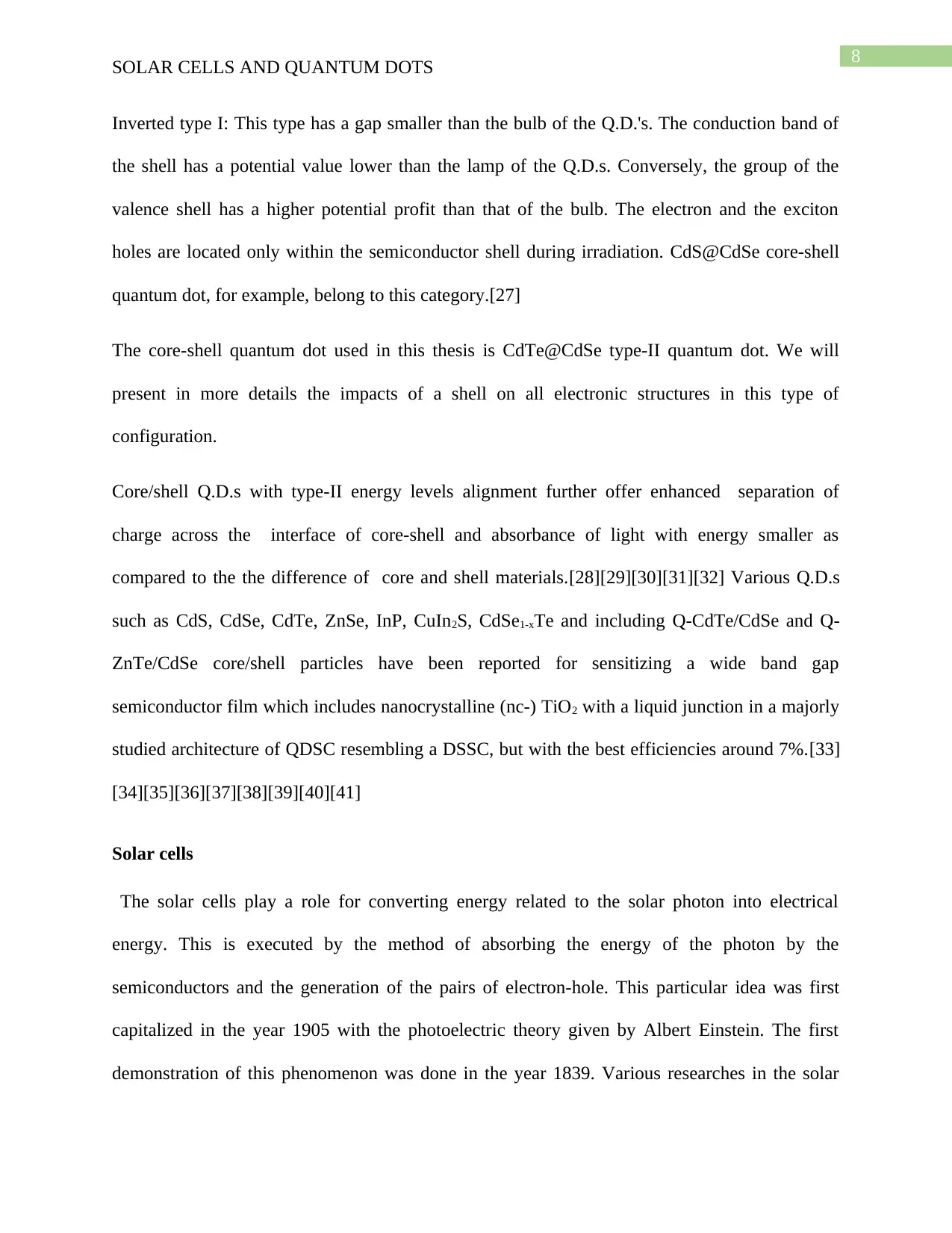
8
SOLAR CELLS AND QUANTUM DOTS
Inverted type I: This type has a gap smaller than the bulb of the Q.D.'s. The conduction band of
the shell has a potential value lower than the lamp of the Q.D.s. Conversely, the group of the
valence shell has a higher potential profit than that of the bulb. The electron and the exciton
holes are located only within the semiconductor shell during irradiation. CdS@CdSe core-shell
quantum dot, for example, belong to this category.[27]
The core-shell quantum dot used in this thesis is CdTe@CdSe type-II quantum dot. We will
present in more details the impacts of a shell on all electronic structures in this type of
configuration.
Core/shell Q.D.s with type-II energy levels alignment further offer enhanced separation of
charge across the interface of core-shell and absorbance of light with energy smaller as
compared to the the difference of core and shell materials.[28][29][30][31][32] Various Q.D.s
such as CdS, CdSe, CdTe, ZnSe, InP, CuIn2S, CdSe1-xTe and including Q-CdTe/CdSe and Q-
ZnTe/CdSe core/shell particles have been reported for sensitizing a wide band gap
semiconductor film which includes nanocrystalline (nc-) TiO2 with a liquid junction in a majorly
studied architecture of QDSC resembling a DSSC, but with the best efficiencies around 7%.[33]
[34][35][36][37][38][39][40][41]
Solar cells
The solar cells play a role for converting energy related to the solar photon into electrical
energy. This is executed by the method of absorbing the energy of the photon by the
semiconductors and the generation of the pairs of electron-hole. This particular idea was first
capitalized in the year 1905 with the photoelectric theory given by Albert Einstein. The first
demonstration of this phenomenon was done in the year 1839. Various researches in the solar
SOLAR CELLS AND QUANTUM DOTS
Inverted type I: This type has a gap smaller than the bulb of the Q.D.'s. The conduction band of
the shell has a potential value lower than the lamp of the Q.D.s. Conversely, the group of the
valence shell has a higher potential profit than that of the bulb. The electron and the exciton
holes are located only within the semiconductor shell during irradiation. CdS@CdSe core-shell
quantum dot, for example, belong to this category.[27]
The core-shell quantum dot used in this thesis is CdTe@CdSe type-II quantum dot. We will
present in more details the impacts of a shell on all electronic structures in this type of
configuration.
Core/shell Q.D.s with type-II energy levels alignment further offer enhanced separation of
charge across the interface of core-shell and absorbance of light with energy smaller as
compared to the the difference of core and shell materials.[28][29][30][31][32] Various Q.D.s
such as CdS, CdSe, CdTe, ZnSe, InP, CuIn2S, CdSe1-xTe and including Q-CdTe/CdSe and Q-
ZnTe/CdSe core/shell particles have been reported for sensitizing a wide band gap
semiconductor film which includes nanocrystalline (nc-) TiO2 with a liquid junction in a majorly
studied architecture of QDSC resembling a DSSC, but with the best efficiencies around 7%.[33]
[34][35][36][37][38][39][40][41]
Solar cells
The solar cells play a role for converting energy related to the solar photon into electrical
energy. This is executed by the method of absorbing the energy of the photon by the
semiconductors and the generation of the pairs of electron-hole. This particular idea was first
capitalized in the year 1905 with the photoelectric theory given by Albert Einstein. The first
demonstration of this phenomenon was done in the year 1839. Various researches in the solar
⊘ This is a preview!⊘
Do you want full access?
Subscribe today to unlock all pages.

Trusted by 1+ million students worldwide
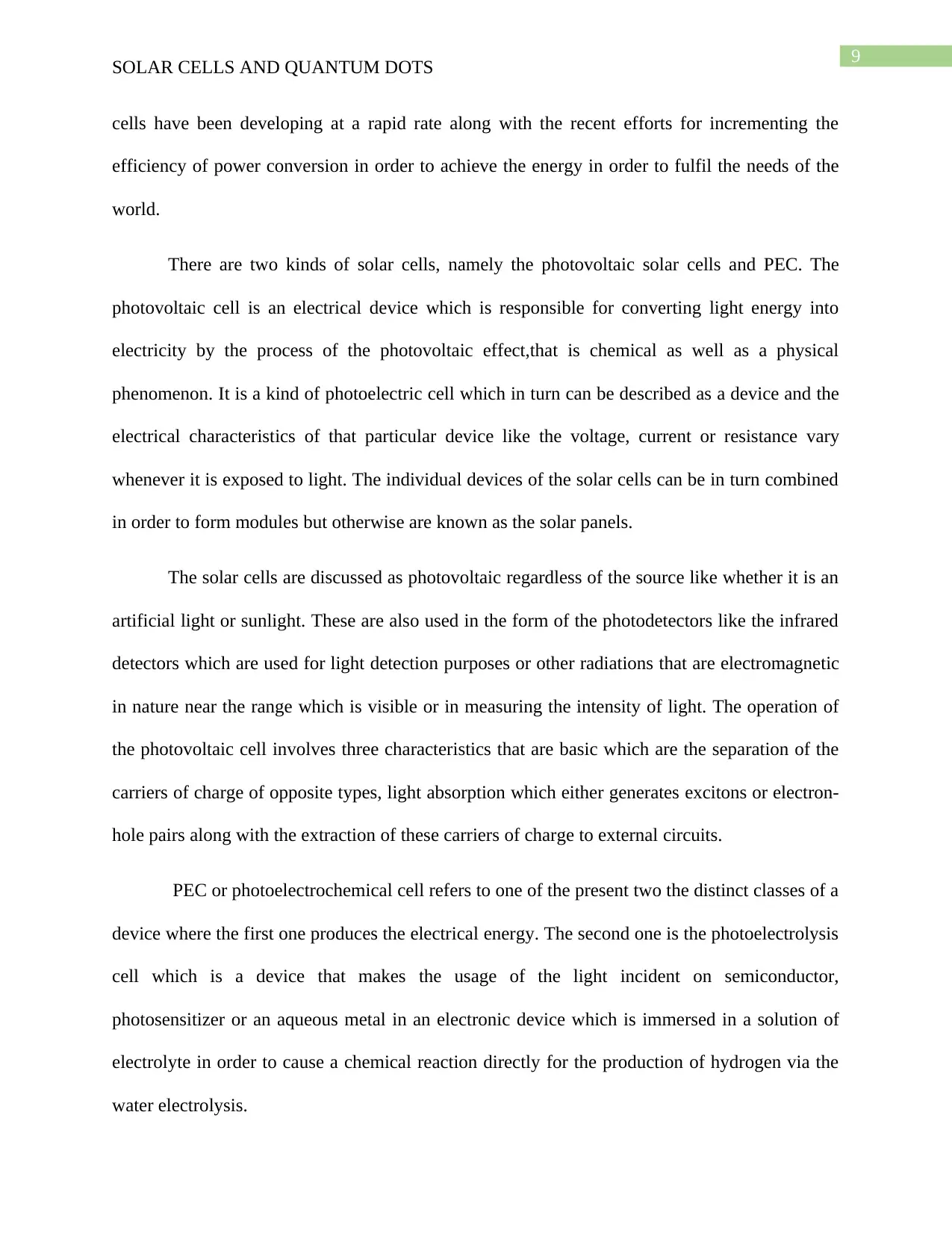
9
SOLAR CELLS AND QUANTUM DOTS
cells have been developing at a rapid rate along with the recent efforts for incrementing the
efficiency of power conversion in order to achieve the energy in order to fulfil the needs of the
world.
There are two kinds of solar cells, namely the photovoltaic solar cells and PEC. The
photovoltaic cell is an electrical device which is responsible for converting light energy into
electricity by the process of the photovoltaic effect,that is chemical as well as a physical
phenomenon. It is a kind of photoelectric cell which in turn can be described as a device and the
electrical characteristics of that particular device like the voltage, current or resistance vary
whenever it is exposed to light. The individual devices of the solar cells can be in turn combined
in order to form modules but otherwise are known as the solar panels.
The solar cells are discussed as photovoltaic regardless of the source like whether it is an
artificial light or sunlight. These are also used in the form of the photodetectors like the infrared
detectors which are used for light detection purposes or other radiations that are electromagnetic
in nature near the range which is visible or in measuring the intensity of light. The operation of
the photovoltaic cell involves three characteristics that are basic which are the separation of the
carriers of charge of opposite types, light absorption which either generates excitons or electron-
hole pairs along with the extraction of these carriers of charge to external circuits.
PEC or photoelectrochemical cell refers to one of the present two the distinct classes of a
device where the first one produces the electrical energy. The second one is the photoelectrolysis
cell which is a device that makes the usage of the light incident on semiconductor,
photosensitizer or an aqueous metal in an electronic device which is immersed in a solution of
electrolyte in order to cause a chemical reaction directly for the production of hydrogen via the
water electrolysis.
SOLAR CELLS AND QUANTUM DOTS
cells have been developing at a rapid rate along with the recent efforts for incrementing the
efficiency of power conversion in order to achieve the energy in order to fulfil the needs of the
world.
There are two kinds of solar cells, namely the photovoltaic solar cells and PEC. The
photovoltaic cell is an electrical device which is responsible for converting light energy into
electricity by the process of the photovoltaic effect,that is chemical as well as a physical
phenomenon. It is a kind of photoelectric cell which in turn can be described as a device and the
electrical characteristics of that particular device like the voltage, current or resistance vary
whenever it is exposed to light. The individual devices of the solar cells can be in turn combined
in order to form modules but otherwise are known as the solar panels.
The solar cells are discussed as photovoltaic regardless of the source like whether it is an
artificial light or sunlight. These are also used in the form of the photodetectors like the infrared
detectors which are used for light detection purposes or other radiations that are electromagnetic
in nature near the range which is visible or in measuring the intensity of light. The operation of
the photovoltaic cell involves three characteristics that are basic which are the separation of the
carriers of charge of opposite types, light absorption which either generates excitons or electron-
hole pairs along with the extraction of these carriers of charge to external circuits.
PEC or photoelectrochemical cell refers to one of the present two the distinct classes of a
device where the first one produces the electrical energy. The second one is the photoelectrolysis
cell which is a device that makes the usage of the light incident on semiconductor,
photosensitizer or an aqueous metal in an electronic device which is immersed in a solution of
electrolyte in order to cause a chemical reaction directly for the production of hydrogen via the
water electrolysis.
Paraphrase This Document
Need a fresh take? Get an instant paraphrase of this document with our AI Paraphraser
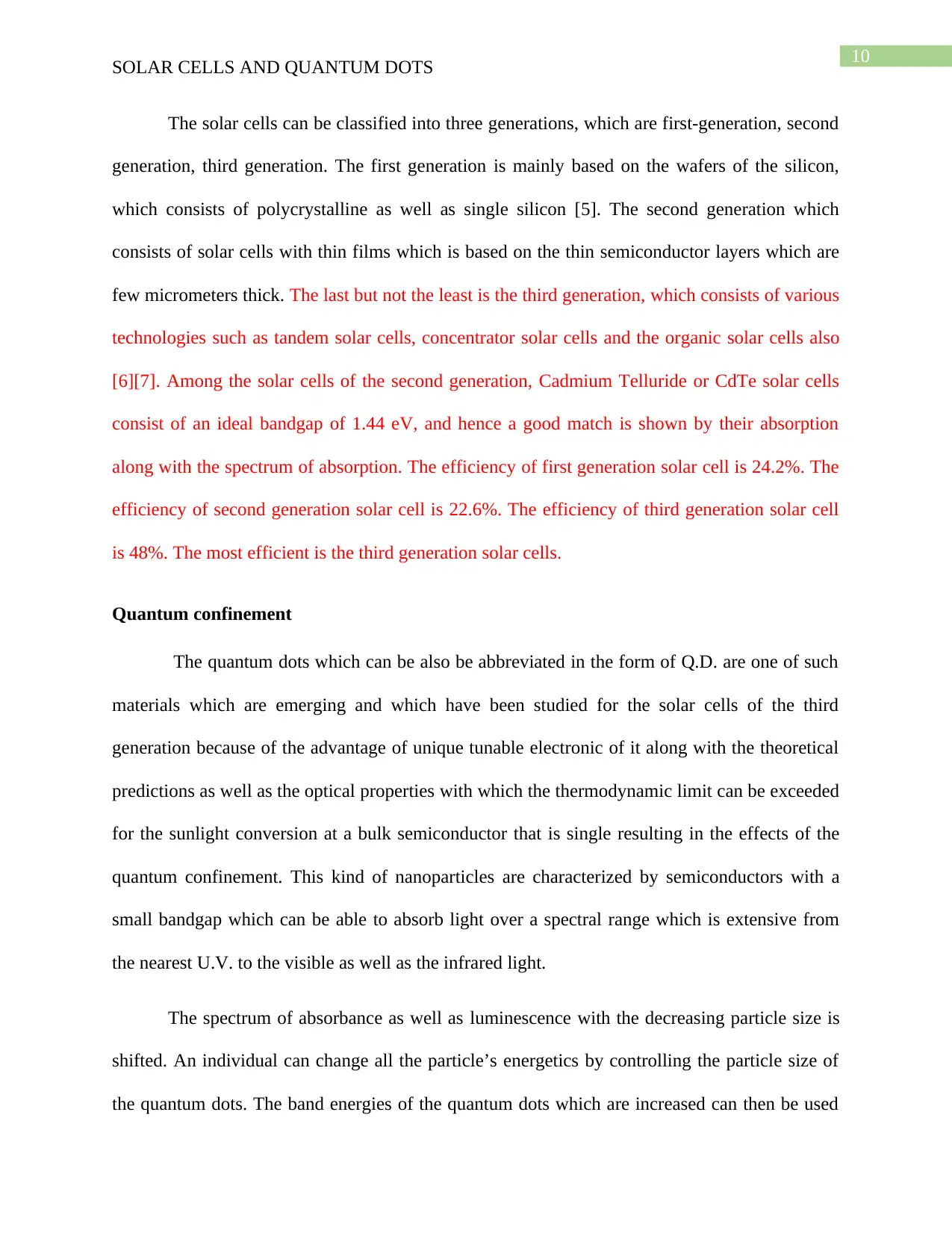
10
SOLAR CELLS AND QUANTUM DOTS
The solar cells can be classified into three generations, which are first-generation, second
generation, third generation. The first generation is mainly based on the wafers of the silicon,
which consists of polycrystalline as well as single silicon [5]. The second generation which
consists of solar cells with thin films which is based on the thin semiconductor layers which are
few micrometers thick. The last but not the least is the third generation, which consists of various
technologies such as tandem solar cells, concentrator solar cells and the organic solar cells also
[6][7]. Among the solar cells of the second generation, Cadmium Telluride or CdTe solar cells
consist of an ideal bandgap of 1.44 eV, and hence a good match is shown by their absorption
along with the spectrum of absorption. The efficiency of first generation solar cell is 24.2%. The
efficiency of second generation solar cell is 22.6%. The efficiency of third generation solar cell
is 48%. The most efficient is the third generation solar cells.
Quantum confinement
The quantum dots which can be also be abbreviated in the form of Q.D. are one of such
materials which are emerging and which have been studied for the solar cells of the third
generation because of the advantage of unique tunable electronic of it along with the theoretical
predictions as well as the optical properties with which the thermodynamic limit can be exceeded
for the sunlight conversion at a bulk semiconductor that is single resulting in the effects of the
quantum confinement. This kind of nanoparticles are characterized by semiconductors with a
small bandgap which can be able to absorb light over a spectral range which is extensive from
the nearest U.V. to the visible as well as the infrared light.
The spectrum of absorbance as well as luminescence with the decreasing particle size is
shifted. An individual can change all the particle’s energetics by controlling the particle size of
the quantum dots. The band energies of the quantum dots which are increased can then be used
SOLAR CELLS AND QUANTUM DOTS
The solar cells can be classified into three generations, which are first-generation, second
generation, third generation. The first generation is mainly based on the wafers of the silicon,
which consists of polycrystalline as well as single silicon [5]. The second generation which
consists of solar cells with thin films which is based on the thin semiconductor layers which are
few micrometers thick. The last but not the least is the third generation, which consists of various
technologies such as tandem solar cells, concentrator solar cells and the organic solar cells also
[6][7]. Among the solar cells of the second generation, Cadmium Telluride or CdTe solar cells
consist of an ideal bandgap of 1.44 eV, and hence a good match is shown by their absorption
along with the spectrum of absorption. The efficiency of first generation solar cell is 24.2%. The
efficiency of second generation solar cell is 22.6%. The efficiency of third generation solar cell
is 48%. The most efficient is the third generation solar cells.
Quantum confinement
The quantum dots which can be also be abbreviated in the form of Q.D. are one of such
materials which are emerging and which have been studied for the solar cells of the third
generation because of the advantage of unique tunable electronic of it along with the theoretical
predictions as well as the optical properties with which the thermodynamic limit can be exceeded
for the sunlight conversion at a bulk semiconductor that is single resulting in the effects of the
quantum confinement. This kind of nanoparticles are characterized by semiconductors with a
small bandgap which can be able to absorb light over a spectral range which is extensive from
the nearest U.V. to the visible as well as the infrared light.
The spectrum of absorbance as well as luminescence with the decreasing particle size is
shifted. An individual can change all the particle’s energetics by controlling the particle size of
the quantum dots. The band energies of the quantum dots which are increased can then be used
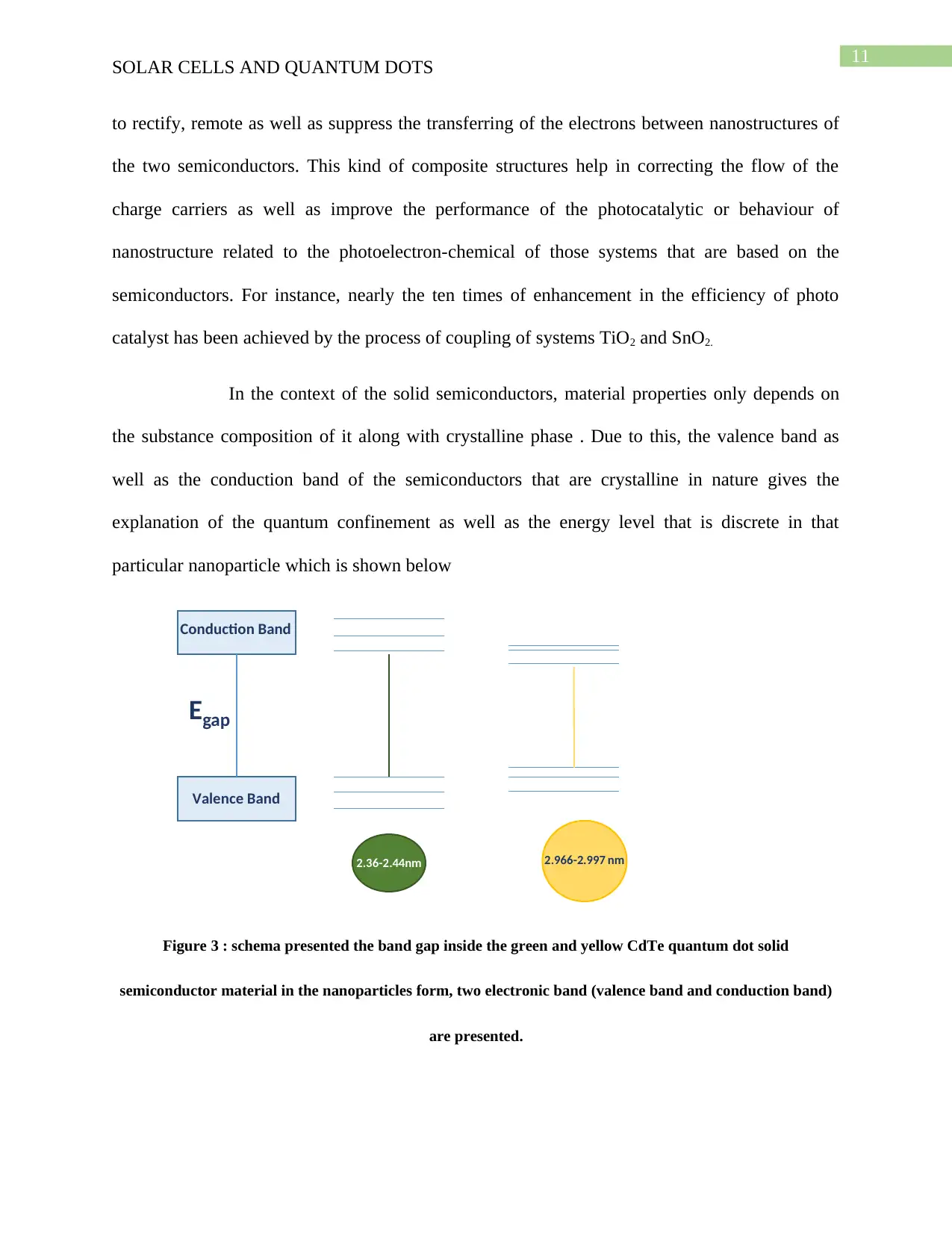
11
SOLAR CELLS AND QUANTUM DOTS
to rectify, remote as well as suppress the transferring of the electrons between nanostructures of
the two semiconductors. This kind of composite structures help in correcting the flow of the
charge carriers as well as improve the performance of the photocatalytic or behaviour of
nanostructure related to the photoelectron-chemical of those systems that are based on the
semiconductors. For instance, nearly the ten times of enhancement in the efficiency of photo
catalyst has been achieved by the process of coupling of systems TiO2 and SnO2.
In the context of the solid semiconductors, material properties only depends on
the substance composition of it along with crystalline phase . Due to this, the valence band as
well as the conduction band of the semiconductors that are crystalline in nature gives the
explanation of the quantum confinement as well as the energy level that is discrete in that
particular nanoparticle which is shown below
Valence Band
Conduction Band
Egap
2.36-2.44nm 2.966-2.997 nm
Figure 3 : schema presented the band gap inside the green and yellow CdTe quantum dot solid
semiconductor material in the nanoparticles form, two electronic band (valence band and conduction band)
are presented.
SOLAR CELLS AND QUANTUM DOTS
to rectify, remote as well as suppress the transferring of the electrons between nanostructures of
the two semiconductors. This kind of composite structures help in correcting the flow of the
charge carriers as well as improve the performance of the photocatalytic or behaviour of
nanostructure related to the photoelectron-chemical of those systems that are based on the
semiconductors. For instance, nearly the ten times of enhancement in the efficiency of photo
catalyst has been achieved by the process of coupling of systems TiO2 and SnO2.
In the context of the solid semiconductors, material properties only depends on
the substance composition of it along with crystalline phase . Due to this, the valence band as
well as the conduction band of the semiconductors that are crystalline in nature gives the
explanation of the quantum confinement as well as the energy level that is discrete in that
particular nanoparticle which is shown below
Valence Band
Conduction Band
Egap
2.36-2.44nm 2.966-2.997 nm
Figure 3 : schema presented the band gap inside the green and yellow CdTe quantum dot solid
semiconductor material in the nanoparticles form, two electronic band (valence band and conduction band)
are presented.
⊘ This is a preview!⊘
Do you want full access?
Subscribe today to unlock all pages.

Trusted by 1+ million students worldwide
1 out of 24
Your All-in-One AI-Powered Toolkit for Academic Success.
+13062052269
info@desklib.com
Available 24*7 on WhatsApp / Email
![[object Object]](/_next/static/media/star-bottom.7253800d.svg)
Unlock your academic potential
Copyright © 2020–2025 A2Z Services. All Rights Reserved. Developed and managed by ZUCOL.